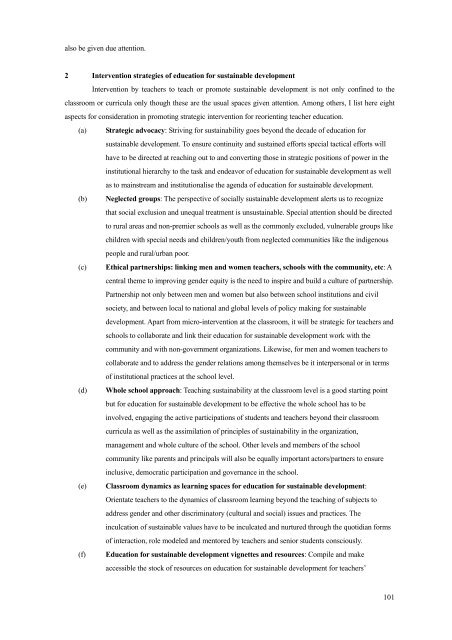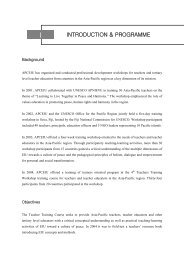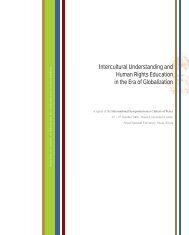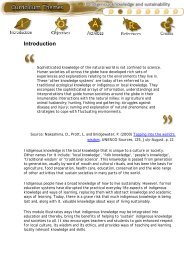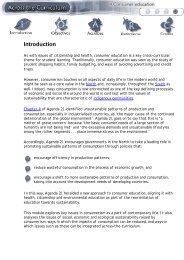REPORT OF UNESCO EXPERT MEETING ON - APCEIU
REPORT OF UNESCO EXPERT MEETING ON - APCEIU
REPORT OF UNESCO EXPERT MEETING ON - APCEIU
You also want an ePaper? Increase the reach of your titles
YUMPU automatically turns print PDFs into web optimized ePapers that Google loves.
also be given due attention.<br />
2 Intervention strategies of education for sustainable development<br />
Intervention by teachers to teach or promote sustainable development is not only confined to the<br />
classroom or curricula only though these are the usual spaces given attention. Among others, I list here eight<br />
aspects for consideration in promoting strategic intervention for reorienting teacher education.<br />
(a) Strategic advocacy: Striving for sustainability goes beyond the decade of education for<br />
sustainable development. To ensure continuity and sustained efforts special tactical efforts will<br />
have to be directed at reaching out to and converting those in strategic positions of power in the<br />
institutional hierarchy to the task and endeavor of education for sustainable development as well<br />
as to mainstream and institutionalise the agenda of education for sustainable development.<br />
(b) Neglected groups: The perspective of socially sustainable development alerts us to recognize<br />
that social exclusion and unequal treatment is unsustainable. Special attention should be directed<br />
to rural areas and non-premier schools as well as the commonly excluded, vulnerable groups like<br />
children with special needs and children/youth from neglected communities like the indigenous<br />
people and rural/urban poor.<br />
(c) Ethical partnerships: linking men and women teachers, schools with the community, etc: A<br />
central theme to improving gender equity is the need to inspire and build a culture of partnership.<br />
Partnership not only between men and women but also between school institutions and civil<br />
society, and between local to national and global levels of policy making for sustainable<br />
development. Apart from micro-intervention at the classroom, it will be strategic for teachers and<br />
schools to collaborate and link their education for sustainable development work with the<br />
community and with non-government organizations. Likewise, for men and women teachers to<br />
collaborate and to address the gender relations among themselves be it interpersonal or in terms<br />
of institutional practices at the school level.<br />
(d) Whole school approach: Teaching sustainability at the classroom level is a good starting point<br />
but for education for sustainable development to be effective the whole school has to be<br />
involved, engaging the active participations of students and teachers beyond their classroom<br />
curricula as well as the assimilation of principles of sustainability in the organization,<br />
management and whole culture of the school. Other levels and members of the school<br />
community like parents and principals will also be equally important actors/partners to ensure<br />
inclusive, democratic participation and governance in the school.<br />
(e) Classroom dynamics as learning spaces for education for sustainable development:<br />
Orientate teachers to the dynamics of classroom learning beyond the teaching of subjects to<br />
address gender and other discriminatory (cultural and social) issues and practices. The<br />
inculcation of sustainable values have to be inculcated and nurtured through the quotidian forms<br />
of interaction, role modeled and mentored by teachers and senior students consciously.<br />
(f) Education for sustainable development vignettes and resources: Compile and make<br />
accessible the stock of resources on education for sustainable development for teachers’<br />
101


